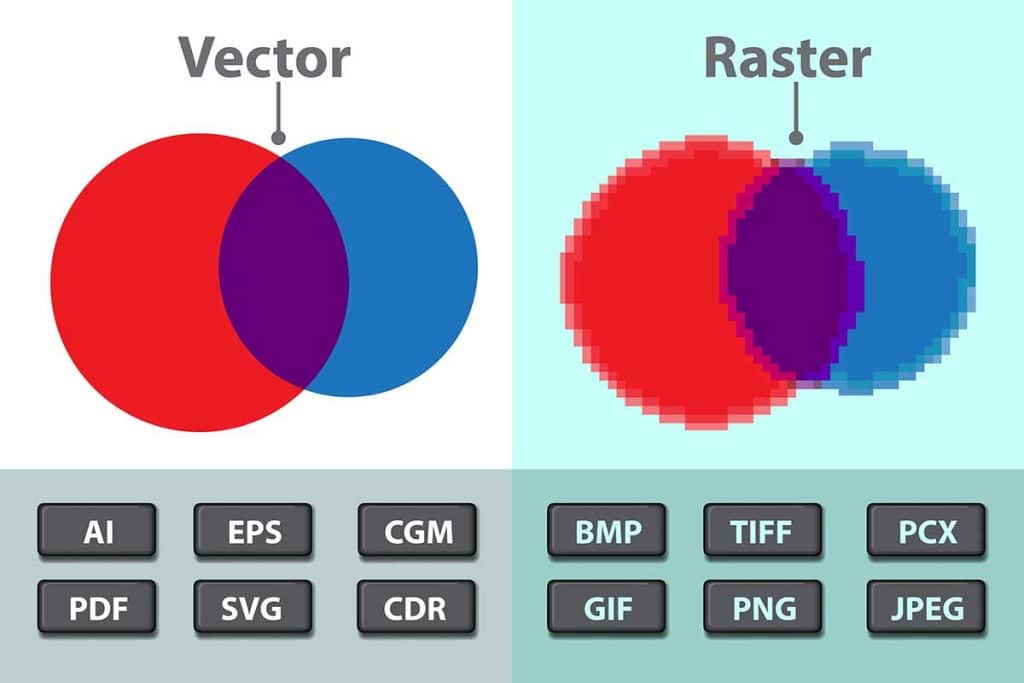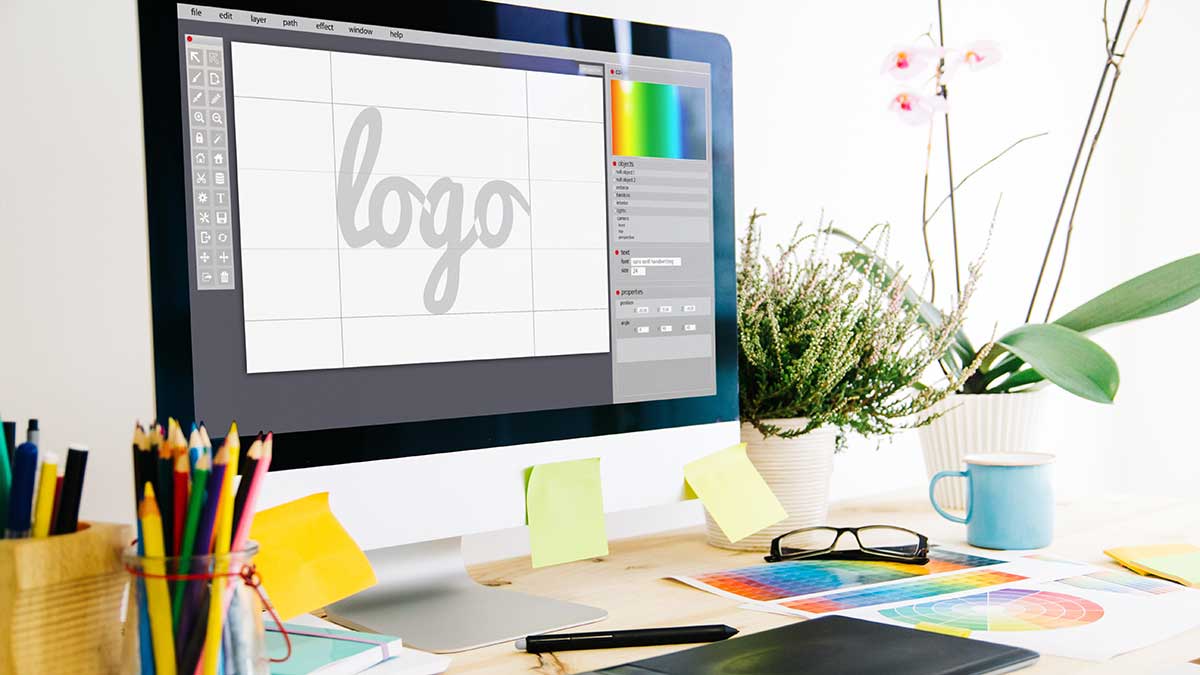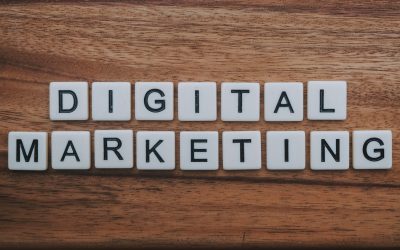A professional logo is more than just a visual symbol; it’s the cornerstone of your brand identity, embodying the essence of your business in a single image. As a business owner, you understand the importance of having a logo that resonates with your target audience. Whether you’ve crafted your logo using Photoshop, Canva, or another design tool, you might now be encountering a common challenge: service providers requesting a vector format version of your logo that you simply don’t have.
This situation can be frustrating, especially when your logo looks perfect on your website but falls short when scaled for printing or signage. The reason behind this is the difference between raster and vector formats. Raster images, like those created in Photoshop or Canva, are made up of pixels, which can cause your logo to lose quality and become pixelated when resized. In contrast, vector logos are created using mathematical equations, ensuring that your logo remains sharp and clear at any size, from a business card to a billboard.
In this article, we’ll explore why having your logo in vector format is essential for your business. We’ll delve into the advantages of vector logos, discuss the industries where they are indispensable, and explain how you can get your logo vectorized to maintain the quality and professionalism your brand deserves. Whether you’re looking to print your logo on merchandise, create large-scale signage, or simply ensure that your brand looks its best across all platforms, understanding the importance of vector logos is a crucial step in elevating your business’s visual identity.
What is a Vector Format Logo?
A vector format logo is a type of digital graphic that is created using mathematical equations rather than pixels. Unlike raster images, which are made up of tiny squares of color (pixels), vector logos are composed of paths defined by points, lines, curves, and shapes. This fundamental difference gives vector graphics their unique ability to be resized without any loss of quality.
At the core of vector graphics is the use of mathematical equations to plot points on a grid. These points are connected by lines and curves, creating shapes that can be scaled infinitely. Whether your logo is displayed on a small business card or blown up on a billboard, the mathematical formulas behind vector graphics ensure the image remains sharp and clear without the blurriness or pixelation that often plagues raster images. Common file formats for vector logos include .AI (Adobe Illustrator), .EPS, and .SVG.
The quality and integrity of your brand’s visual identity are paramount, and a vector logo plays a critical role in maintaining these standards. A logo is often the first impression potential customers have of your business, and it needs to look flawless across all mediums. Whether you’re printing your logo on large banners, embroidering it onto apparel, or using it in digital advertising, a vector format ensures that your logo retains its sharpness and professionalism, regardless of the size or application. In contrast, a raster-based logo might look fine on your website but appear blurry and unprofessional when resized for other uses, potentially undermining your brand’s credibility.
By ensuring that your logo is in vector format, you’re safeguarding the consistency and quality of your brand’s visual representation, which is crucial for building and maintaining a solid brand identity.

Why Your Business Needs a Vector Logo
A logo is more than just a symbol; it’s the face of your brand and a vital part of your business identity. Having a logo that looks polished and professional across all platforms is essential for making a strong, lasting impression on your audience. While you may have started with a raster-based logo, transitioning to a vector format offers significant advantages that can elevate your brand. Here’s why your business needs a vector logo:
Scalability
One of the most significant benefits of a vector logo is its ability to be scaled to any size without losing quality. Whether you need your logo on a tiny social media icon or a massive billboard, a vector logo will maintain its crispness and clarity. This scalability is crucial for businesses that use their logo across a wide range of applications, from website headers to large-scale signage. With a vector logo, you can ensure that your brand is represented consistently and professionally, no matter the size.
Versatility
Vector logos are incredibly versatile, allowing for easy editing and modification. If you need to change the color, tweak the design, or create different versions of your logo for various purposes, a vector file makes these adjustments straightforward and precise. This flexibility is particularly beneficial for businesses that frequently update their branding or need multiple logo variations for different products, services, or campaigns. With a vector logo, your brand can adapt and evolve without compromising its visual integrity.
Consistency
Consistency is key in branding, and vector logos help ensure that your logo looks the same across all mediums. Whether it’s printed on business cards, embroidered on uniforms, or displayed on your website, a vector logo will appear identical in every instance. This uniformity strengthens brand recognition and reinforces your company’s identity, making it easier for customers to recognize and remember your brand.
Professionalism
A professional logo is a mark of a serious business, and having your logo in vector format contributes to that perception. When your logo is sharp, clear, and consistent across all platforms, it reflects your attention to detail and commitment to quality. Potential clients and partners will see your business as professional and trustworthy, which can be a deciding factor in their decision to work with you. A vector logo not only enhances your brand’s visual appeal but also signals that you value excellence in every aspect of your business.
Challenges with Complex Logos
It’s important to note that not all logos are easily converted to vector format, especially those that incorporate photographs, intricate shading, or complex gradients—elements that are often achievable in tools like Photoshop. While these features can create visually stunning designs, they don’t always translate well into vector graphics, which rely on clean lines and shapes.
Converting such logos into vector format can be challenging and may require significant adjustments or even a complete redesign to maintain the logo’s integrity while ensuring it meets the scalability and versatility that vector formats offer. If your current logo includes these complex elements, it’s worth consulting with a professional logo designer to explore the best approach for vectorization while preserving the essence of your brand.
Transitioning your current logo to a vector logo is a strategic investment in your brand’s future. It ensures that your logo is scalable, versatile, consistent, and professional, all of which are crucial for maintaining a strong and recognizable brand identity.
Industries That Require Vector Logos
Vector logos are not just a luxury; they are necessary for many industries where precision, scalability, and consistency are critical. From design and print to large-scale manufacturing and media production, vector logos ensure your brand is represented clearly and professionally across all platforms. Let’s explore the specific needs of various industries that rely on vector-based logos to maintain brand integrity.
Graphic Design and Branding
The importance of a vector logo cannot be overstated in graphic design and branding. Designers need to create logos that are both scalable and editable, allowing them to be adapted for a wide range of applications, from tiny icons to large advertisements. Vector logos provide the flexibility to adjust designs without losing quality, ensuring the brand’s identity remains solid and recognizable in every context.
Printing and Publishing
High-quality print materials are essential for any business looking to make a lasting impression, and vector logos play a key role in achieving this. Whether it’s business cards, brochures, or promotional products, vector logos ensure that every printed item looks sharp and professional. Unlike raster images, which can become pixelated when enlarged, vector logos maintain their clarity and crispness, providing a polished finish that reflects well on the brand.
Advertising and Marketing
Consistency is crucial in advertising and marketing, where a brand’s logo needs to be instantly recognizable across various platforms. Vector logos allow for seamless integration into both digital and physical marketing campaigns, ensuring that the logo appears consistently, whether on a website, in a magazine, or on a billboard. This consistency strengthens brand recognition and helps build trust with the audience.
Apparel and Merchandise
When it comes to apparel and merchandise, precision is key. Vector logos are essential for producing clear and precise branded products, whether it’s screen printing on t-shirts, embroidering on hats, or laser engraving on promotional items. The sharp lines and scalable nature of vector logos ensure that the brand’s identity is accurately represented, regardless of medium or material.
Signage and Large Format Printing
Signage and large-format printing require logos that can be scaled to enormous sizes without losing detail or clarity. Vector logos are perfect for this purpose, as they can be enlarged indefinitely while maintaining sharpness. Whether it’s a storefront sign, vehicle wrap, or trade show banner, vector logos ensure the brand’s message is delivered with impact and precision.
Web Design and Development
In web design and development, vector logos offer significant advantages, particularly in creating responsive and retina-ready designs. As websites are viewed on devices of all sizes, from smartphones to large desktop monitors, vector logos ensure the brand’s logo looks sharp and clear on every screen. Additionally, vector files can be easily converted into scalable web formats like SVG, which load quickly and maintain high quality.
Architecture and Engineering
Architectural and engineering plans often incorporate logos into their designs, requiring a level of precision that only vector graphics can provide. Vector logos are used in blueprints, CAD drawings, and presentations to ensure that the brand’s identity is represented clearly and accurately. The ability to scale the logo without loss of quality is essential in these industries, where even the smallest details matter.
Broadcast and Media Production
In the broadcast and media production industry, high-resolution graphics are a must. Vector logos are essential for creating sharp, high-quality visuals that can be used in television, film, and online video content. Whether it’s for an on-screen logo bug, lower-third graphics, or animated logo sequences, vector logos ensure that the brand’s identity is maintained at the highest visual standard.
Event Planning and Exhibition Design
Event planning and exhibition design often involve creating large-scale graphics and displays that must maintain brand integrity from up close and at a distance. Vector logos are crucial in these settings, ensuring that the brand’s logo appears consistently and clearly on everything from event signage to booth designs. The scalability and sharpness of vector logos help reinforce the brand’s presence in a crowded and competitive environment.
Manufacturing
In manufacturing, vector logos are essential for the precision and scalability required to incorporate logos into products. Whether it’s etching a logo onto a product, creating molds, or designing packaging, vector logos provide the accuracy needed to ensure that the brand’s identity is represented clearly and consistently. The ability to scale the logo without losing quality is particularly important in this industry, where the logo may need to be resized to fit different products or packaging types.
In summary, vector logos are indispensable across a wide range of industries, each requiring the scalability, precision, and consistency that only vector graphics can provide. By ensuring that your logo is in vector format, you are not only safeguarding your brand’s visual identity but also positioning your business to thrive across multiple platforms and mediums.
The Process of Vectorizing a Logo
Vectorizing a logo is the process of converting a raster image (composed of pixels) into a vector format (composed of paths and mathematical equations). This conversion is essential for ensuring that your logo can be scaled, edited, and reproduced with clarity and precision across various platforms and sizes. Below, we’ll explore the steps involved in vectorizing a logo, the tools used, and why it’s often best to seek professional help for this process.
Explanation of Vectorization
Vectorization involves taking a raster logo—such as one created in Photoshop, Canva, or another pixel-based tool—and converting it into a vector format. Raster logos are made up of individual pixels, which can result in a loss of quality when the logo is resized or printed on large surfaces. In contrast, vector logos are built using mathematical equations that define lines, curves, and shapes, allowing the logo to be scaled infinitely without losing clarity.
Steps Involved in Converting a Raster Logo to a Vector Format
- Assessing the Existing Logo: The first step is to analyze the current logo to determine its complexity and the elements that need to be converted. Simple logos with clean lines and solid colors are generally easier to vectorize, while logos with intricate details, gradients, or photographic elements may require more advanced techniques.
- Tracing the Logo: Using vector design software, the next step involves tracing the existing logo to recreate it as a vector graphic. This can be done manually or through automated tools within the software. Manual tracing allows for greater precision and control, particularly for complex designs.
- Recreating Shapes and Lines: During the tracing process, shapes, lines, and curves are recreated using the pen tool or other vector tools within the software. This step involves carefully following the original design to ensure that the vectorized logo closely matches the raster version.
- Adding Colors and Effects: After the shapes and lines are in place, colors and effects are added to match the original logo. Gradients and shading may need to be simplified or recreated using vector techniques, as not all effects from raster images can be directly translated into vector format.
- Refining and Finalizing: Once the logo is fully traced and colors are added, the final step is to refine the design. This includes adjusting any imperfections, ensuring symmetry, and making sure the logo scales correctly at all sizes.
- Exporting the Vector File: The completed vector logo is then exported in various formats such as .AI (Adobe Illustrator), .EPS, .SVG, and .PDF. These formats are widely accepted by printers, designers, and other professionals who may need to use the logo in different applications.
Tools and Software
To vectorize a logo, professionals typically use specialized design software that offers the tools necessary for precise vectorization. Some of the most popular tools include:
- Adobe Illustrator: The industry standard for vector graphic design, Adobe Illustrator offers a wide range of tools for creating and editing vector logos. Its pen tool, shape builder, and live trace options make it highly versatile for vectorization tasks.
- CorelDRAW: Another powerful vector design tool, CorelDRAW is known for its user-friendly interface and advanced vectorization features. It’s a popular choice among designers who need to create detailed vector graphics.
- Inkscape: An open-source vector graphic editor, Inkscape is a cost-effective alternative to Adobe Illustrator. While it may not have all the advanced features of Illustrator, it offers robust tools for basic vectorization and is a great option for small businesses or designers on a budget.
Importance of Professional Help
While it’s possible to vectorize a logo using the tools mentioned above, achieving a high-quality result often requires the expertise of a professional designer. Here’s why businesses should consider hiring an expert to vectorize their logos:
- Precision and Quality: Professional designers have the skills and experience to ensure that your logo is vectorized with precision, maintaining the integrity of the original design while optimizing it for various applications. They can handle complex logos that may be difficult to convert accurately without advanced techniques.
- Time and Efficiency: Vectorizing a logo can be time-consuming, especially if the original design is intricate or contains elements that don’t easily translate to vector format. A professional can complete the process more efficiently, allowing you to focus on other aspects of your business.
- Customization and Refinement: Experts can offer valuable input on improving your logo during the vectorization process. Whether it’s refining the design, adjusting colors, or enhancing certain elements, a professional designer can help you get the most out of your logo.
- Access to Professional Tools: Designers have access to the latest software and tools that may not be available to the average business owner. This access allows them to produce higher quality vector files that meet industry standards.
Vectorizing your logo is a critical step in ensuring that your brand’s identity remains sharp, clear, and professional across all mediums. While there are tools available for do-it-yourself vectorization, hiring a professional can provide the precision, quality, and customization needed to truly elevate your brand.

Benefits of Having a Vectorized Logo
Investing in a vectorized logo is not just about ensuring your logo looks good; it’s about setting your brand up for long-term success. A vector logo offers a range of benefits that extend far beyond aesthetics, impacting your business’s bottom line, brand perception, and adaptability across various platforms. Let’s explore some of the key advantages of having a vectorized logo.
Long-Term Cost Savings
A vectorized logo represents a one-time investment that can save your business money in the long run. Because vector logos are scalable and versatile, you won’t need to create multiple versions of your logo for different applications. Whether you need a small logo for a business card or a large one for a billboard, the same vector file can be used without sacrificing quality. This eliminates the need for costly redesigns or re-creations down the line, making it a cost-effective solution that pays off over time.
Enhanced Brand Perception
A sharp, professional logo is a cornerstone of a strong brand identity. When your logo looks clean and polished across all mediums, it signals to your audience that your business is professional, trustworthy, and detail-oriented. This enhanced brand perception can set you apart from competitors, making your brand more memorable and appealing. A vectorized logo ensures that your brand’s visual representation is always at its best, helping to build credibility and foster positive associations with your business.
Versatility Across Platforms
One of the most significant advantages of a vectorized logo is its adaptability across various platforms and mediums. Whether you’re designing a website, printing merchandise, or creating signage, a vector logo can be seamlessly integrated into any format without losing quality. This versatility ensures that your brand maintains a consistent and professional appearance, no matter where it’s displayed. From digital screens to physical products, a vector logo provides the flexibility your business needs to effectively communicate its identity.
So, as you can see, a vectorized logo is an invaluable asset that offers long-term cost savings, enhances brand perception, and provides unmatched versatility across platforms. By investing in a vector logo, you’re not only elevating your brand’s visual identity but also positioning your business for success in an increasingly competitive market.
How to Get Your Logo Vectorized
If your logo is currently in a raster format and you’ve recognized the need for a vector version, the next step is to get it professionally vectorized. While there are tools available that allow for do-it-yourself vectorization, hiring a professional ensures that your logo is accurately converted and optimized for all your branding needs. Here’s how to go about getting your logo vectorized effectively.
Hiring a Professional
When it comes to vectorizing your logo, seeking professional services is the best way to ensure quality results. Professional designers have the expertise and tools necessary to convert your logo with precision, maintaining the integrity of the original design while enhancing its scalability and versatility.
A professional will also be able to handle any complex elements in your logo, such as intricate shading or gradients, that might not translate well in a DIY approach. Investing in a professional service not only saves you time but also guarantees that your logo will look its best across all applications.
What to Look For
Selecting the right designer or service to vectorize your logo is crucial. Here are some tips on what to look for:
- Experience and Portfolio: Choose a designer with a strong portfolio that includes examples of vector logos they have created or converted. Experience in logo design and vectorization is key to achieving a high-quality result.
- Client Reviews and Testimonials: Look for reviews and testimonials from previous clients to gauge the reliability and quality of the designer’s work. Positive feedback from others can give you confidence in your choice.
- Communication and Process: A good designer will be communicative and transparent about their process. They should be willing to discuss your specific needs, provide a clear timeline, and keep you informed throughout the project.
- Software Proficiency: Ensure that the designer is proficient in industry-standard vector software, such as Adobe Illustrator. This ensures that the final product will be delivered in the correct formats that are widely accepted in the industry.
- Custom Solutions: Every logo is unique, and a professional should offer custom vectorization solutions that cater to your specific design rather than using generic auto-tracing methods.
Ready to take your logo to the next level? At Nora Kramer Designs, we specialize in creating and vectorizing logos that are not only visually striking but also versatile and scalable for all your branding needs. With years of experience in graphic design, we have the skills and tools to ensure that your logo maintains its integrity across all platforms and sizes.
Don’t settle for a logo that falls short of representing your brand’s full potential. Contact us today to discuss how we can help you vectorize your logo and elevate your brand identity. Let us turn your current logo into a powerful, professional asset that serves your business for years to come.
Conclusion
A vector format logo is more than just a file type; it’s a strategic investment in your brand’s visual identity and long-term success. Throughout this article, we’ve explored the numerous benefits of vector logos, including their scalability, versatility, and consistency, which are crucial for maintaining a professional brand image across all platforms. We’ve also discussed the specific needs of various industries, from graphic design and advertising to manufacturing and media production, where vector logos play an essential role in ensuring that a brand’s identity is represented with precision and clarity.
By investing in a vectorized logo, you’re setting your business up for long-term savings, enhanced brand perception, and the ability to adapt your logo for any medium, from digital screens to physical products. Whether you’re starting with a new logo or looking to convert an existing one, ensuring that your logo is in vector format is a critical step in safeguarding your brand’s visual identity.
Don’t let your logo fall short of its potential. Investing in a vector logo is a key move to elevate your brand and ensure it stands out with professionalism and clarity. Reach out to Nora Kramer Designs today to learn more about how we can help you create or vectorize your logo, ensuring that your brand remains strong, recognizable, and adaptable across all platforms. Let’s work together to build a visual identity that truly represents the quality and excellence of your business.
- How a Boutique Web Design Agency Offers More Personalized Service - June 23, 2025
- When Should You Redesign Your Website? 7 Warning Signs - June 20, 2025
- We’re Honored: Named One of the Best Web Design Blogs in Florida by FeedSpot - June 10, 2025




